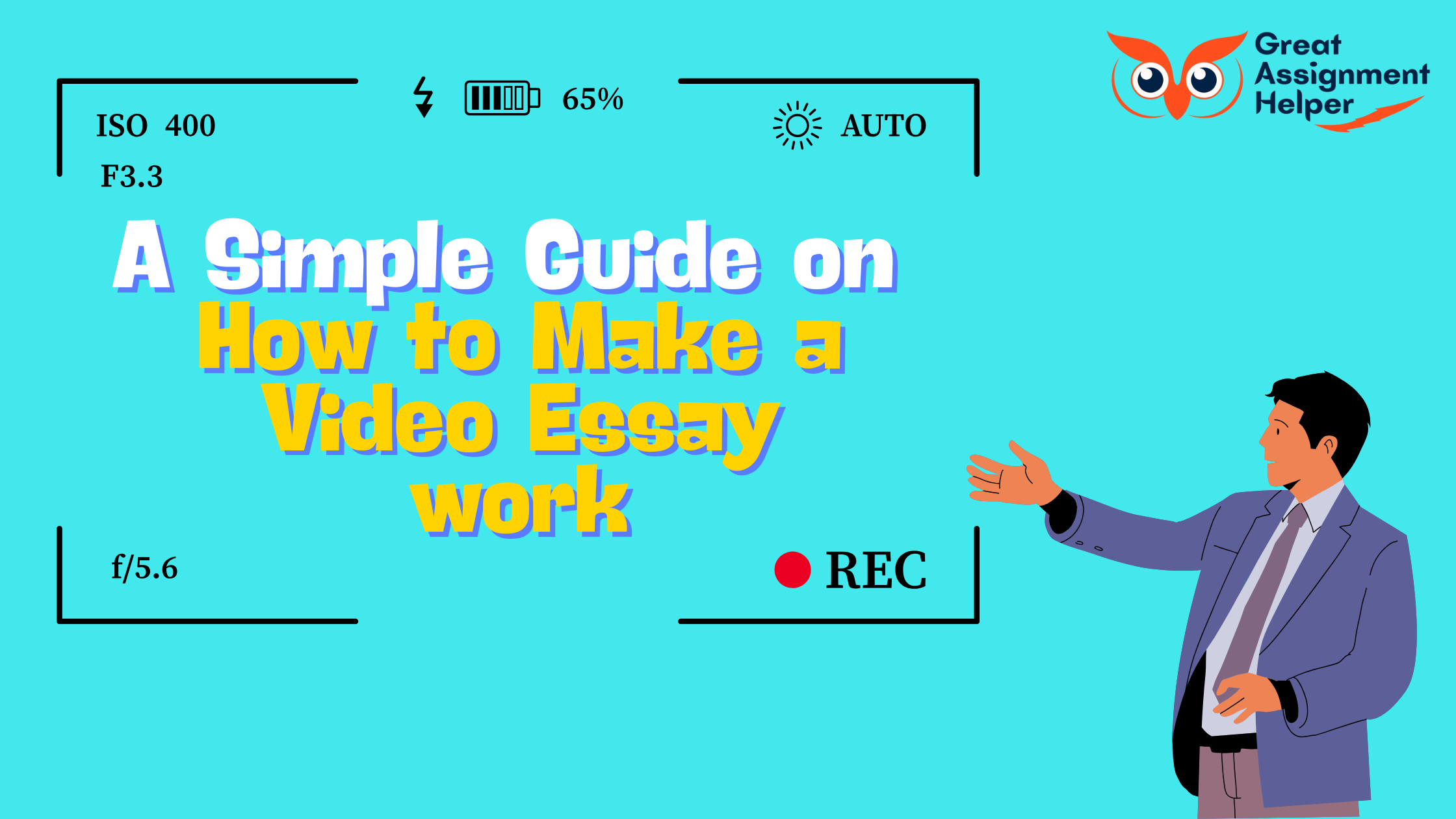
Creating a video essay is an exciting and immersive way to present ideas, blending storytelling, research, and multimedia elements to engage audiences on a deeper level. Unlike traditional essays, video essays allow creators to combine visuals, narration, music, and text, making complex topics more accessible and emotionally impactful. Learning how to make a video essay can enhance the presentation of personal reflections, academic research, or creative concepts, offering a unique platform to showcase insights in a way that captivates and informs viewers. In this guide, we’ll walk through each essential step, from selecting the perfect topic to editing the final product, helping you understand the nuances of crafting a video essay. Whether you’re looking to create a powerful academic piece or a thought- provoking narrative, mastering the art of the video essay opens up a world of creative possibilities that can elevate your content to new heights.
Listen To This Blog
Understanding the Video Essay Format
Creating a video essay combines the creativity of filmmaking with the analytical depth of written essays, offering a unique way to communicate ideas. Video essays leverage visual storytelling, sound, and narration, creating an immersive experience that appeals to both sight and sound. By understanding the video essay format, creators can effectively present complex information in a format that is both engaging and memorable. Here, we’ll break down what makes a video essay distinct, why it’s effective, and provide examples of popular video essays that have captivated audiences worldwide.
What is a Video Essay?
A video essay is a short film or multimedia project that analyzes a specific topic, concept, or piece of media. Like a traditional written essay, a video essay includes a thesis, supporting arguments, and a conclusion. However, it takes advantage of visuals, sound, and editing techniques to convey information in ways that a purely written piece cannot. Video essays often use narration to guide viewers through the content, while visuals enhance or emphasize the points being made. This combination of multimedia elements makes video essays a powerful tool for storytelling and analysis.
Unlike a documentary, which generally presents objective facts and interviews, a video essay is often subjective, allowing the creator to add personal insights, creative interpretations, and unique stylistic choices. This creative flexibility has made video essays particularly popular on platforms like YouTube, where creators explore a vast range of topics, from film analysis to social issues, through this format.
Why is the Video Essay Format Effective?
Video essays have gained popularity because they can communicate complex information in an accessible and engaging manner. This format combines auditory and visual elements, which can aid memory retention and deepen viewer engagement. Research has shown that people often understand and retain information better when it’s presented both visually and audibly. By synchronizing images, music, and narration, video essays cater to multiple learning styles and keep viewers’ attention.
Moreover, the video essay format allows creators to convey tone and emotion effectively. For instance, adding specific music, using unique camera angles, or emphasizing certain words or images can evoke a particular mood or draw attention to essential points. This combination of emotional appeal and intellectual content creates a rich experience that often resonates with viewers more deeply than a traditional essay.
Popular Examples of Video Essays
1. Every Frame a Painting – One of the most popular video essay series on YouTube, Every Frame a Painting, by Tony Zhou, analyzes filmmaking techniques, exploring how directors use composition, editing, and cinematography to tell a story. Zhou’s essays on directors like Martin Scorsese and Edgar Wright have become widely recognized for their deep insights and engaging delivery.
2. Lindsay Ellis’ Film Critique Series – Lindsay Ellis is known for her in-depth analysis of movies and media trends. Her video essay on Disney's & Beauty and the Beast" remake and her series on the Transformers" franchise highlight cultural implications in popular media, blending humor with thoughtful critique.
3. Nerdwriter1 – Another famous YouTube channel, Nerdwriter1, covers topics ranging from art history to politics through video essays. His video How Donald Trump Answers a Question is a popular example of how the format can be used to analyze public figures and contemporary issues creatively.
4. ContraPoints – Natalie Wynns ContraPoints channel tackles social and philosophical topics with humor, thoughtful critique, and high production value. Her video essays use costumes, sets, and elaborate staging to present ideas in a way that feels more like a performance, making complex issues relatable and entertaining.
These creators have popularized the video essay format and demonstrated its effectiveness in making challenging subjects accessible to a broader audience. Whether examining visual techniques, dissecting cultural phenomena, or critiquing social issues, these video essays show how the format allows for deeper analysis through dynamic storytelling. Understanding this format and its potential can inspire new creators to produce their own impactful video essays that captivate and inform viewers.
Choosing a Compelling Topic
Selecting the right topic is crucial when making a video essay, as it forms the foundation for the entire project. A compelling topic not only resonates with the audience but also keeps them engaged throughout the video. When brainstorming topics, creators should consider their audience's interests, the video’s purpose, and the message they want to convey. Here, we’ll go through some methods for brainstorming and offer tips on aligning your topic with the video essay’s purpose to ensure a strong, cohesive theme.
Brainstorming Topics That Resonate with Your Audience
To choose a topic that captivates viewers, start by thinking about what appeals to your audience. Your video essay should connect with your audience’s interests, current trends, or topics that inspire curiosity. Begin with a brainstorming session where you jot down ideas, explore different perspectives, and look for themes that excite you. Consider the following strategies:
1. Identify Popular Trends and Themes – Explore popular trends on platforms like YouTube, social media, or news sites. Topics that are timely or relate to trending issues tend to capture the audience’s attention. If your audience is interested in social issues, for example, a topic like "The Rise of Eco- Conscious Fashion" could be engaging.
2. Think About What Interests You Personally – Often, the best video essays come from creators who are passionate about their subject. When brainstorming, consider what genuinely fascinates you. A video essay allows you to share your unique perspective, so choose a topic that you’re curious to explore deeply. Enthusiasm is contagious, and your passion for the topic will resonate with your viewers.
3. Research Audience Preferences – If you have an established audience, analyze what topics they respond to most. Reviewing comments, feedback, or viewership patterns on previous videos or similar content can give you insights into what your audience likes. This approach can help you create content that not only aligns with your interests but also meets your audience’s expectations.
Tips for Aligning Your Topic with the Video Essay’s Purpose
After brainstorming, it’s essential to refine your topic by ensuring it aligns with the purpose of your video essay.
A clear purpose provides direction and strengthens the overall narrative. Here are some tips to help you create a focused, cohesive video essay.
1. Define Your Central Message
Every video essay should have a central message or question it seeks to answer. Once you have a broad topic, narrow it down by asking what you want viewers to take away. For instance, if your topic is The Influence of Nostalgia on Modern Cinema, your central message could explore how nostalgic elements attract audiences. This message should be clear and consistent throughout the video, guiding your analysis and conclusions.
2. Ensure Relevance to Your Audience’s Interests
While the topic may interest you, it’s crucial that it also appeals to your audience. For example, if you’re creating content for a young, digital-savvy audience, focusing on topics related to social media, technology, or pop culture might resonate more. If your audience values intellectual discourse, topics related to philosophy or literature might be more engaging.
3. Stay Focused and Avoid Overly Broad Topics
A successful video essay often explores a single theme or question in depth. Avoid choosing a topic that’s too broad, as it can lead to a disjointed narrative and overwhelm the viewer. For example, instead of a broad topic like "The History of Cinema," focus on something more specific, such as The Evolution of Cinematic Storytelling Techniques. This approach allows for a deeper dive and more insightful commentary.
4. Consider Emotional and Intellectual Appeal
Topics that evoke an emotional response or encourage intellectual reflection often have a strong impact. Try to choose a topic that connects on both levels. For instance, a video essay on "The Portrayal of Mental Health in Animation" could be both emotionally engaging and intellectually stimulating, making it more memorable for viewers.
Drafting an Outline
A well-organized outline is the backbone of any successful video essay, providing a roadmap for the flow and structure of your content. Outlining ensures your thoughts are organized logically, helping you present a clear and compelling argument or narrative. By crafting a structured outline, you can maintain focus, enhance the quality of your video essay, and make editing smoother. Here’s a guide on creating an effective outline that flows logically and enhances the clarity of your message.
Creating a Logical Structure
1. Introduction
Start with an engaging introduction that captures the viewer’s attention. Briefly present your topic and state the purpose or thesis of your video essay. The introduction sets the stage for the content that follows, so make it clear and intriguing. This section should outline what the audience can expect and why the topic is relevant.
2. Body of the Essay
The body of your video essay is where you develop your main points. Divide it into sections, each covering a specific aspect of your topic. Each section should flow naturally into the next, creating a seamless transition that guides the viewer through your argument or narrative. For example, if your video essay analyzes a film, you might organize the body by themes, character analysis, and cinematic techniques.
o Main Argument or Point 1
Begin with your first main point, providing evidence, examples, and analysis. Keep your audience engaged by balancing facts with insights and personal commentary.
o Supporting Argument or Point 2
Continue with additional points that support your thesis. These should be arranged logically, with each point building upon the previous one. This approach maintains the flow and keeps the narrative cohesive.
o Additional Arguments (if necessary)
Add further sections as needed, ensuring each segment aligns with your central theme and adds depth to your argument or narrative.
3. Conclusion
The conclusion should summarize your key points and restate the thesis, providing closure for the viewer. Avoid introducing new information; instead, focus on reinforcing the main insights or takeaways. An impactful conclusion leaves the audience with a lasting impression and a clear understanding of your perspective.
Importance of Organizing Your Thoughts
A structured outline helps you communicate more effectively by keeping your thoughts organized and preventing off-topic tangents. Outlining ensures each part of the video essay contributes to a cohesive argument, making it easier for viewers to follow your ideas. When your content flows logically, it’s more likely to resonate with your audience, allowing them to fully engage with and understand your message.
Writing a Script
Crafting a natural-sounding script is essential for creating an engaging video essay. A well-written script not only guides your content but also helps keep your delivery smooth and relatable. Here are some techniques to achieve a conversational tone and tips for practicing your delivery to make it engaging.
Techniques for Scripting to Sound Natural
1. Write as You Speak
Use simple, conversational language to make your script sound authentic. Imagine speaking directly to your audience rather than reading from a page. Short sentences, contractions, and everyday expressions can help your script feel more approachable.
2. Add Pauses and Emphasis
Incorporate pauses for effect and vary the tone to emphasize key points. These elements create a natural rhythm, helping your audience stay engaged and giving your words more impact.
3. Avoid Overly Formal Language
Keep it casual. Formal language can feel stiff on video, so use vocabulary that aligns with how you’d speak in person.
Tips for Practicing Delivery
1. Rehearse Out Loud
Practice reading the script aloud multiple times. This helps you identify any awkward phrasing and smooth out transitions, making your delivery more fluid.
2. Use Gestures and Facial Expressions
Non-verbal cues add energy to your presentation. Practicing with gestures and expressions can make your video more dynamic and engaging for viewers.
Integrating Visuals and Audio
Combining well-chosen visuals and audio can greatly enhance the effectiveness of your video essay, making it more engaging and easier to follow. Selecting relevant visuals and optimizing audio quality helps your narrative resonate with viewers on multiple levels.
How to Select Relevant Visuals
1. Choose Visuals that Reinforce Key Points
Use images, video clips, or graphics that directly relate to the points you’re making. This helps reinforce your message visually and keeps the audience engaged. For example, if discussing a historical event, include archival footage or related imagery.
2. Balance Visual Variety with Consistency
Avoid overloading the video with too many visual styles. Consistency in design or theme helps maintain a cohesive feel, while occasional visual changes keep the viewer’s attention.
Audio Tips to Improve the Viewing Experience
1. Use Quality Audio Equipment
Clear audio is crucial for engagement, so use a good microphone and reduce background noise to ensure your voice is easy to understand.
2. Incorporate Background Music Thoughtfully
Soft background music can add depth but should be subtle and not overpower your narration. Adjust music volume appropriately to maintain focus on the spoken content, enhancing the overall experience without distraction.
Using Editing Software
Editing software plays a crucial role in transforming raw footage into a polished video essay. For beginners, it’s essential to use software that is user-friendly yet powerful enough to achieve professional results. Here are some recommended tools and key features to focus on for a high-quality final product.
Recommendations for Beginner-Friendly Editing Tools
1. iMovie (Mac) iMovie is a free, intuitive tool that offers basic editing capabilities like trimming, transitions, and simple effects, making it perfect for beginners on Apple devices.
2. DaVinci Resolve (Windows, Mac, Linux) DaVinci Resolve offers professional-level features, and the free version includes a range of tools for color correction, audio editing, and visual effects.
3. Adobe Premiere Rush (Windows, Mac, iOS, Android) Adobe Premiere Rush is designed for beginners, with straightforward editing tools and cloud syncing, making it easy to edit on multiple devices.
Key Features to Focus on for a Polished Final Product
1. Transitions and Cuts
Use smooth transitions between clips to create a seamless flow. Cut out unnecessary parts to keep the pacing steady and engaging.
2. Color Correction and Audio Balancing
Adjust color to make visuals look vibrant and consistent. Balance audio levels for clear sound, ensuring background music doesn’t overpower narration. These features will help create a polished, professional-looking video essay that keeps viewers engaged.
Final Review and Submission
Before submitting your video essay, a thorough review is essential to ensure clarity, engagement, and technical quality. This final step helps catch any errors and ensures that your video meets all necessary requirements, especially if its for academic purposes.
Steps to Ensure Quality and Engagement
1. Watch the Video Multiple Times
Review the video from start to finish to check for any visual or audio inconsistencies. Look out for abrupt transitions, background noise, or errors in text overlays.
2. Seek Feedback
Ask friends or colleagues to watch your video. A fresh perspective can help identify areas that may need improvement or clarification.
3. Double-Check Visuals and Audio Sync
Ensure that visuals align with your narration and that any background music or sound effects are balanced, enhancing rather than distracting from your message.
Highlighting Submission Guidelines for Academic Video Essays
1. Check for Length and Format Requirements
Adhere to any specified time constraints, file formats, or resolution standards. Academic institutions often have specific guidelines, such as limiting video length or requiring a certain format (e.g., .mp4 or .mov).
2. Ensure Proper Citations
If you’ve referenced any external sources, make sure these are credited appropriately in the video or accompanying submission materials, adhering to any academic integrity guidelines.
Following these steps ensures a smooth submission process and enhances the overall quality of your video essay.
Conclusion
Creating a video essay can seem overwhelming, but with a clear plan, it becomes manageable and highly rewarding. Remember, the quality of content always takes precedence over technical mastery. Focus on delivering a strong message and engaging visuals, and you’ll make a lasting impact. For those seeking extra assistance, Great Assignment Helper offers valuable support at every step, from brainstorming and scripting to refining your final project. They provide trusted assignment help to bring academic and creative projects to life, ensuring your video essay stands out with compelling ideas and polished execution.

